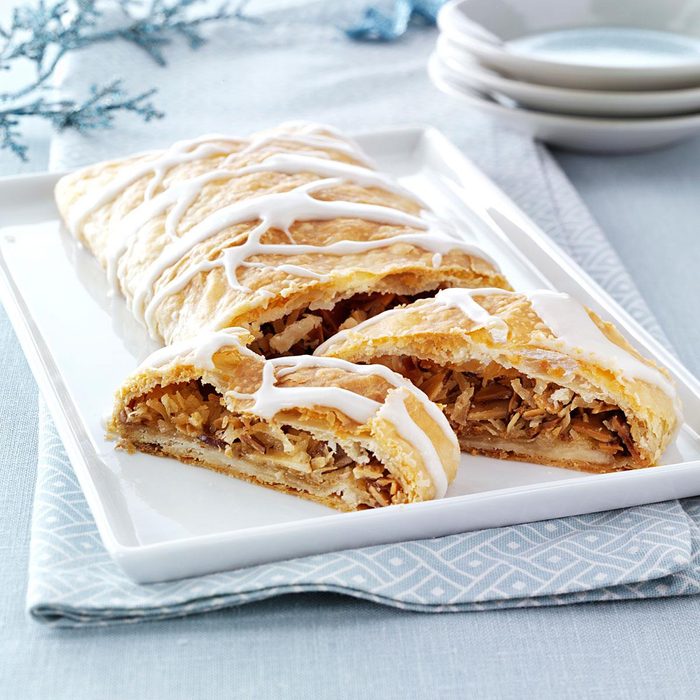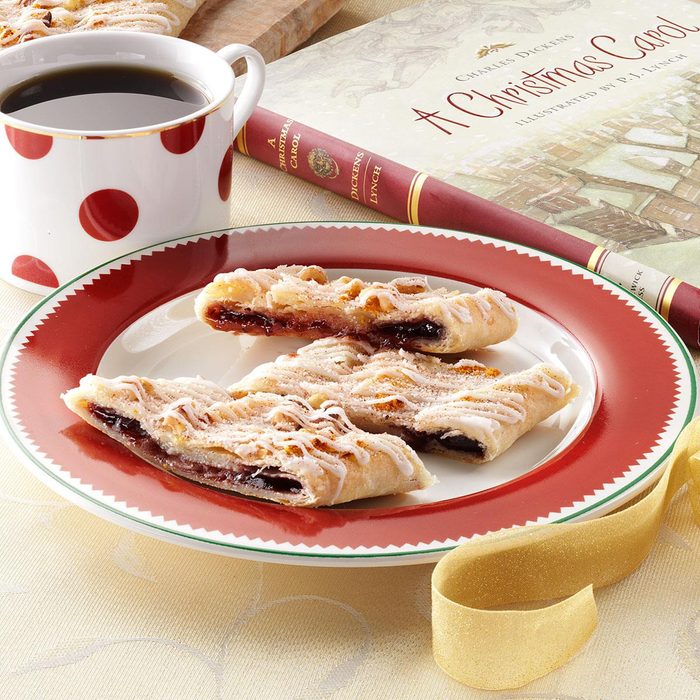If you’re from Wisconsin, particularly Southeastern Wisconsin, you’re probably familiar with Danish kringle. We won’t get into which bakery makes the best kringle—that discussion can get pretty heated among Wisconsin natives. But we will share our homemade kringle recipe and explain exactly what makes this delectable pastry so special!
Find more of the best recipes from Wisconsin.
What Is Kringle?

Kringle is a buttery, flaky, ring-shaped pastry made from a tender, laminated Viennese pastry dough. Kringle is loaded with an array of fruit or nut fillings—almond, pecan and cherry are among the most popular. Baked until golden, kringle is typically topped with sweet icing and then sliced and served alongside coffee for breakfast or brunch.
Kringle came to the United States in the late 1800s with Danish immigrant bakers who settled in Racine, Wisconsin. Today, Racine remains the capital for superior Danish kringle in the U.S., with a number of beloved family-owned kringle shops (like O&H Bakery) that have been in business for generations.
Step-by-Step Kringle Recipe
Making kringle is not for the faint of heart! But it’s certainly worth the effort if you’re up for a baking challenge. The delicate pastry begins as a crumbly mixture of flour, butter, sugar, salt, yeast, egg and milk. It develops for several hours in the fridge to form a smooth dough. After this initial chill, the dough is rolled thin, folded and chilled several times before being filled and shaped into its iconic ring.
Yield: This recipe makes (2) 12-inch kringles.
Ingredients

Dough
- 1 cup (125g) all-purpose flour
- 1 cup (125g) bread flour
- 3 tablespoons (40g) granulated sugar
- 2-1/4 teaspoons (7g) instant yeast
- 1 (8g) teaspoon salt
- 1 cup (225g) cold unsalted butter, cut into small cubes
- 1⁄3 cup (80ml) milk, chilled
- 1 large egg, cold
Filling
- 1/2 cup (100g) light brown sugar
- 3 tablespoons pure maple syrup
- 2 cups (200g) pecans
- 4 tablespoons (55g) butter, melted
- 1 egg, for egg wash
Icing
- 1 cup (125g) confectioners’ sugar
- 1/2 teaspoon vanilla extract
- 1/8 teaspoon salt
Directions
Step 1: Start the dough

In a large mixing bowl, combine the all-purpose flour, bread flour, sugar, yeast and salt. Stir to combine. Next, add the cubed butter and cut it into the dry ingredients, using a pastry blender, until the butter resembles coarse, semi-uniform crumbs that are a little larger than pea-sized.
Editor’s tip: If you own a large enough food processor, you may do the initial mixing of the dough in there. Combine the butter and dry ingredients in the bowl of the food processor and pulse until the mixture reaches the consistency described above.
Step 2: Add wet ingredients

In a small bowl, whisk together the milk and egg. Then, add the milk and beaten egg to the flour-butter mixture. Using a rubber spatula, stir together until moistened and then turn the mixture out onto a clean surface.
Step 3: Knead and shape

Working quickly, use your hands to gently knead the mixture until it comes together to form a smooth, yet crumbly, dough.
Shape into a rectangle and then wrap tightly with plastic wrap. Chill the dough in the refrigerator for at least 4 hours and up to 2 days.
Step 4: Make the filling

To prepare the filling, finely blend half of the pecans in a food processor. Transfer the pecans to a small bowl and combine with sugar, maple syrup and melted butter. Mix together and set aside.
Step 5: Roll, fold and chill again

After chilling, roll the dough, on a lightly floured surface, into an 8×15 inch rectangle. Fold rectangle into thirds, like a brochure, bringing the short ends toward the center. Rotate dough 90 degrees, then roll out again into an 8×15-inch rectangle. Repeat the folds again and then wrap the dough tightly in plastic wrap and chill for 20-30 minutes.
Step 6: Repeat the lamination
Repeat the rolling and folding process (called lamination) in its entirety two more times, chilling 20 minutes between sessions. After the final fold, wrap the dough in plastic wrap and chill for a final 20-30 minutes before assembling.
Editor’s tip: Not ready to bake? No worries. The wrapped dough can be kept in the refrigerator for up to 3 days, or freezer for 2 months. Defrost frozen dough overnight in the refrigerator then proceed to the next step.
Step 7: Assemble the kringle

Line two, large rimmed sheet pans with parchment paper. Unwrap the dough and cut it in half. Return one half of the dough to the fridge and place the other half on a lightly floured work surface. Roll the dough into a 5×30 inch rectangle.
Spread half of the filling in an even strip down the center of the dough—about 1-1/2 inches wide.
Editor’s tip: Less is more when it comes to the filling. The filling should not be mounded high, but low and flat. Overfilling will weigh down the pastry as it bakes and also make the pastry more prone to tears and leaks while in the oven.
Step 8: Fold and seal
Next, seal the filling inside the kringle by taking one long side of the rectangle and folding it over the filling, pressing gently to adhere. Then, use a pastry brush to brush the remaining unfolded third of the dough with egg before folding the dough over the center. Next, use your fingers to tightly pinch the seam together along the length of the dough as well as the seams on the short ends as well.
Step 9: Shape and proof

Remeasure dough to make sure it’s at least 30 inches long, stretching to the appropriate length, if necessary. Transfer the dough to one of the parchment-lined baking sheets, seam-side down, and gently shape into an oval. Tuck and pinch together where the ends of the dough meet, then cover loosely with plastic wrap. Let the kringle proof in a warm spot for 30 minutes until it has puffed slightly.
Editor’s tip: While the first kringle proofs, you may fill and shape the second kringle by repeating steps 7-9. Alternatively, you may save the other half of the dough for future use.
Step 10: Bake

Preheat the oven to 375°F with your oven’s rack in the center position. Brush the proofed pastry with egg wash and then bake until deeply golden; about 18-22 minutes.
Editor’s tip: If you choose to bake both kringles, we recommend baking one at a time for best results. Bake the first while the second one proofs and then bake the second while the first one cools. This method will result in kringle that’s more evenly baked.
Step 11: Prepare the icing

While the kringle bakes, whisk together the icing ingredients in a small bowl until smooth. Cover and set aside.
Step 12: Flatten and cool
Remove promptly from the oven and immediately take a clean baking sheet or heavy cast-iron pan and gently compress the pastry to flatten it slightly. You want to do this while the kringle is still piping hot and pliable so it doesn’t crack or tear when you flatten it. Once flattened, let cool completely.
Step 13: Top with icing
Once the kringle is cool, drizzle or spread the icing over the top of the kringle. Let the icing set and then slice and serve the kringle in pieces as desired.
Common Questions About Making Kringle
Can I use 100% all-purpose flour if I don’t have bread flour?
In testing, we found using a mixture of half bread flour and half all-purpose yielded the kringle with the best rise, shape, color and texture. However, using all-purpose entirely is doable. Just make sure to choose a quality all-purpose flour with a high protein content.
Are all those folds really necessary?
YES! While laborious, all those folds in the pastry are critical for successful kringle making. As the pastry bakes, the butter melts between the folds and traps steam inside the dough to create all those lovely flaky layers. So don’t skimp on the folds.
How can I make a fruit-filled kringle?
Simply swap the pecan filling for your favorite fruit pie filling (store-bought or homemade). Prior to adding the filling, pulse it a few times in the food processor to break down any super large pieces of fruit. Then, drain off any excess liquid and add to the kringle as outlined in step 7. Fold, shape and bake as directed.
How should kringle be stored?
Kringle is best eaten within 24 hours of baking. However, leftover kringle can be stored at room temperature in an air-tight container for up to 3 days.
The post How to Make a Flaky Danish Kringle Recipe at Home appeared first on Taste of Home.
Lauren Habermehl





